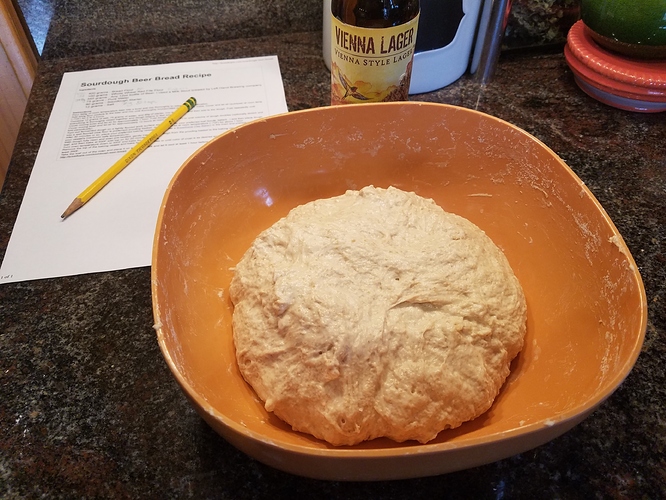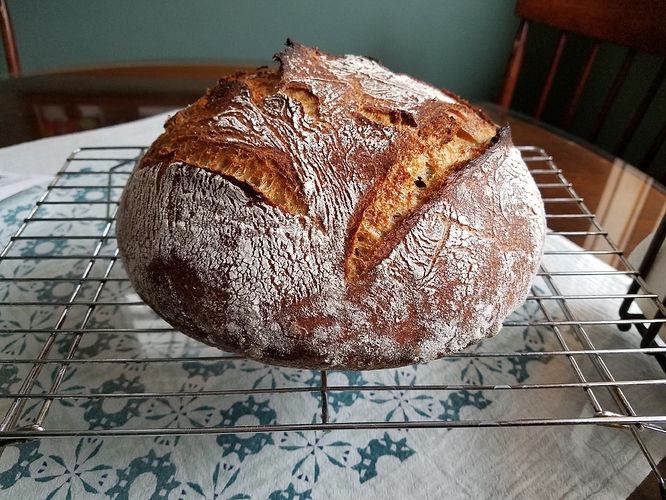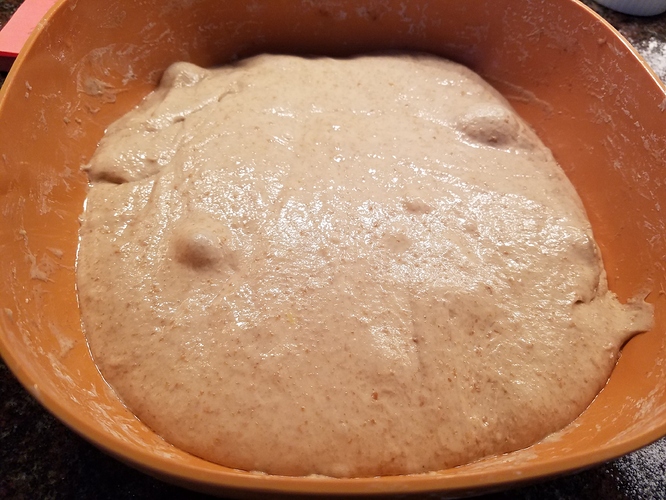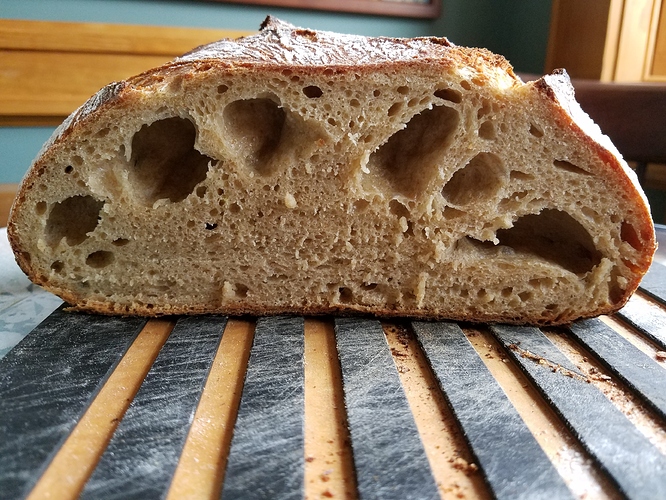<img src="/uploads/default/original/2X/3/364b9abcebd397de6d4982a1f19f616f29f56c28.JPG" width=“375” height=“500” Wonderful oven spring and flavor outstanding, Royal
Thank you for the inspiration to try this. However, I totally improvised as my conversions from metric must have been way off. Thus, it took 3 days to make going in and out of fridge until I got the right consistency. Also at some point I added yeast because it didn’t seem to be rising at all with just the sourdough. It tastes great.
I can’t wait to see how this turns out. I have a new scale, which was fun to use for the first time. But I guess my starter is super wet and my substitution flours are not very thirsty, because I had to add 100 g more flour to get past pancake batter.
450g AP flour
150g einkorn
1 bottle Vienna lager
75 g water
80 g starter
8 g salt (I dropped this because my husband’s not into salt and I’ve never used more than 1.5 tsp in a loaf of bread. 8 g was 2 rounded tsp)
Thanks for the recipe. I’ll post end result in a day or two.
Very nice. What type of beer did you use?
I’m so happy you enjoyed this recipe. Nice idea using a Dunkel. Very malty. Conversions can be a pain. I tend to use a scale and weigh my ingredients because it’s easier to replicate and share a recipe. Cups/Tbsp/tsp measurements can vary and easily throw off a recipe.
That’s surprising you needed to add that much extra flour. How much beer did you add?
I’m really looking forward to see how your bread comes out. Please do post a picture.
Finally getting in the math of this, after at least a hundred loaves of winging it 
Please tell me if I am off as this is my first attempt at calculating hydration.
Apparently, my starter is about 140% hydration. I feed the same volume of flour and water. According to my scale, a 1/4 cup of my flour is 34g flour and a scant quarter cup of water is 48g. (My starter floats and performs great, and I don’t bother waiting to see doubling, I guess because the bubbles rise through the thin liquid and pop?) At 140% hydration, 80g of starter is about 47g water and 33g flour.
My liquid was: 348g beer +75g water + 47g water from starter = 470
My flour was: 600g + 33g flour from the starter = 633
74% hydration
Does that sound about right - in terms of calculation and in terms of what you’d want for the recipe?
Wow, that is some next level baking. The math looks correct to me. I’d like the hydration to be closer to 80% but 74% is a good place to start. You can always add a little bit of water if the dough feels too dry. Based on the numbers I believe this recipe hydration is around 85%.
Let me know how it comes out.
I usually do not post on forums. This one is well deserved and needed to be recognized. I have been baking nothing but sourdough bread for a few a couple of years now. This bread is one of the best I have made. Thank you for sharing the recipe. I was somewhat nervous. I usually don’t work much with high hydration bread and when I moved this from my brotform into my Clay baker it fell drastically. I was so afraid I was going to have a loaf of bread a couple of inches high. When I took the top off I could not believe how much it raised 4-5". Not only did it raise well, the flavor and texture was amazing. Again thank you so much!
We used Erdinger Weißbier (pictured here), but I plan to try others too. I’d prefer to get a really dark, complex beer and see how that goes. But the Erdinger gave the bread a very nice flavor.
You are welcome. I’m so glad you had a successful baking experience. The Breadtopia forum is a safe place where we can all share our successes and failures in baking. We look forward to hearing about your future baking endeavors.
Nice choice of beers. The great thing about this recipe is you can use almost any type of beer. The flavor profile and aroma of the beer will come out in the bread. My only suggestion is to stay away from the really high alcohol beers 11% abv or higher. I believe the alcohol breaks down the gluten structure and decreases the health of the starter you add to the dough.
If you really love a good barley wine or belgian quad and you want to add to the recipe then just add less beer and replace with more water.
The algebra did almost break my brain lol. I’ll admit I got help from a math major.
W water, F flour
Starter 140℅ hydration
How to determine flour and water content in 80g of starter…
W/F = 1.4
W = 1.4F
F + W = 80
F + 1.4F = 80
2.4F = 80
F = 80/2.4
F = 33
Whatever though…onto the important stuff.
Here is a pic of my bread!! It looks and smells so good! Like a previous poster in this thread, I thought it would be flattish when I put in into the dutch oven, but it rose high.
I used very wet hands for 4 stretch and folds, to up the hydration. I put it in the fridge overnight midway thru the bulk fermentation because of bad timing. 1 am would not be a good time for me to be shaping a loaf.
The flavor and texture of this bread are awesome.
Can someone look at my pics and diagnose wth I did to get this crumb structure?
At end of long and varied temp bulk fermentation.
Before rest and shape.
The dough proofed for an hr at room temp, then I flipped it into the dutch oven.
What does this mean? I’ve large holes but never so specifically located!
That looks really good.
And thanks for the breakdown of how you did the math. I’ll bookmark your equation for future use. Thank you.
Oooo, nice picture Fermentada! Makes me hungry!
That is a very interesting distribution of holes. As a wild guess, I’m going to say it’s a result of a combination of the refrigerated bulk proof and cold folding / shaping leaving the loaf with some differential layering in its internal structure.
I’ve never seen that particular distribution, but I have definitely noticed that sometimes the way that holes show up inside my loaves seem to be directly the result of how I folded and shaped before the final proof. I’m somehow imagining that folding / shaping dough right out of the fridge might exaggerate that to some degree because the stiffness of the cold dough would make the layers of the folds more resistant to melding together. Just a theory.
In any case, beautiful loaf!
Thanks for the loaf compliments.
Paul, I agree - I think the cold folds (also done late and at kinda random times) may be the culprit.
I was doing an olive-rosemary loaf at the same time, and didn’t fold it at all, and the holes were even.
Taste on the beer bread was super. Definitely will repeat. 




